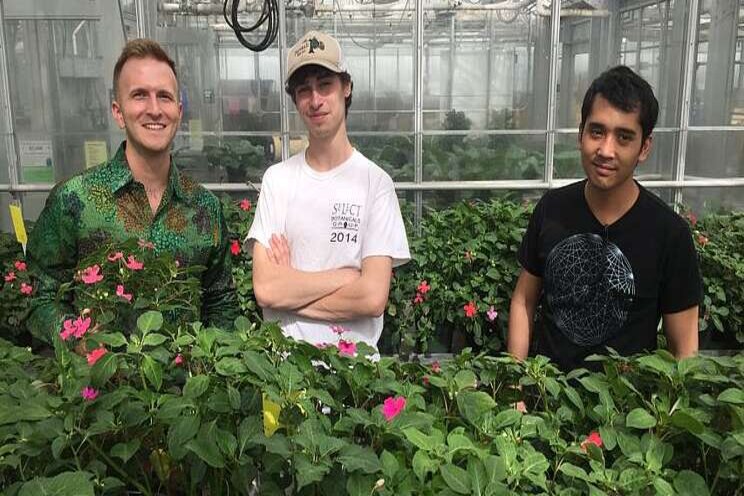Breeding a more disease-resistant impatiens
Added on 20 June 2021


Trial hoop houses showing varieties both resistant and susceptible to impatiens downy mildew.
In 2010, there were $151 million in sales of impatiens in the U.S. By 2011, IDM had spread across the nation and worldwide, and by 2012, sales were only a fraction of their previous value. The nationwide emergence of IDM caused losses in production that proved devastating to the bedding plant industry.
In the past two years, there have been some cultivars of IDM-resistant impatiens that have been introduced to the North American market by commercial seed companies. However, there remains an imperative need to fill the market niche left by I. walleriana.
Here at Cornell University, we are using traditional plant breeding procedures to produce impatiens that are resistant to IDM. Our strategy is to integrate resistance into the common impatiens by hybridizing with other native impatiens species that are resistant to the disease. This procedure allows us to widen genetic diversity and increase the options for resistance.
Identifying Ideal Species
When we began this research, the first step was to collect a diverse population of Impatiens species from around the world. These plants were screened for durable resistance to IDM under controlled-environmental conditions. From these studies, resistant species were identified for the breeding program.
After identifying IDM-resistant species of impatiens, the next step was to hybridize these resistant species with common impatiens to introgress resistance. Tissue culture, a process of growing plants on a nutrient medium under aseptic and controlled- environmental conditions, was vital for this plant improvement activity. Because impatiens plants have explosive seed pods, it is difficult to collect seeds from mature seed pods. To avoid this problem, the tissue culture technique called embryo rescue is being used. During this process, immature ovaries (seeds) from hybridized plants are removed from the mother plants approximately 13 days after pollination and placed in tissue culture until germination. After the seeds germinate and produce their cotyledonal leaves, they are removed from tissue culture, transplanted onto a greenhouse medium, and placed under an intermittent mist system to acclimate and grow.
These novel plants are grown in the greenhouses and asexually propagated to produce clones of each plant. When early summer arrives, they are planted outside in the field trials at Cornell University's Long Island campus where they are subjected to natural IDM. Planted among the new hybrid plants are commercial cultivars of impatiens that are known to be susceptible to IDM; these are the control plants. At the end of the summer, resistant plants are identified and used for further breeding.
How Research Is Paying Off
In 2015, the first two interspecific hybrids of impatiens that are resistant to attack from IDM were identified. These two noteworthy plants were cross pollinated and self pollinated to produce offspring. From these crosses, plants with a wide variety of flower colors and growth habits were produced. These offspring were also field tested for resistance to IDM and eventually many attractive, resistant plants were produced.
For introduction of these to the commercial market, they would need to be vegetatively propagated. This kind of propagation adds an additional layer of complexity and expense to the grower. Therefore, after discussing this situation with several New York greenhouse growers, the decision was made to continue with our breeding program with the goal to produce IDM-resistant impatiens that are seed propagated.
There have been several landmark discoveries during this breeding project. We have confirmed that IDM resistance is genetically inherited with impatiens. We have shown that the popular Impatiens walleriana is compatible for cross-fertilization with other Impatiens species that are resistant to IDM and that the ornamental qualities of the common impatiens can be combined with the disease resistance of the wild relatives to produce improved plants.
This past summer of 2020, we had some very exciting results from the field trials. Our research demonstrated that there is polygenic inheritance to IDM resistance with our impatiens hybrids. This kind of inheritance indicates that two or more nonallelic genes are involved collectively in determining inherited resistance to IDM. What this means is resistance to IDM will possibly be greater than those resistant hybrids that are currently available.
Currently, with the help of undergraduate and graduate students, our breeding of Impatiens continues. We plan to use the success of the past six years to continue breeding for new and more diverse forms of Impatiens that are both resistant to IDM and seed propagated.
The author would like to thank the American Floral Endowment, the Gloeckner Foundation, and the New York Farm Viability Institute for funding this research.
Header Photo Caption: Students involved in the project include Dr. James Keach, now an Assistant Professor at the University of Hawaii; Patrick McLoughlin, who was an undergrad at the time and is headed to the University of Florida this fall for a Ph.D. program; and MS student Kamal Nor.
Source and Photo courtesy of Greenhouse Grower
Source: Greenhouse Grower
More news















